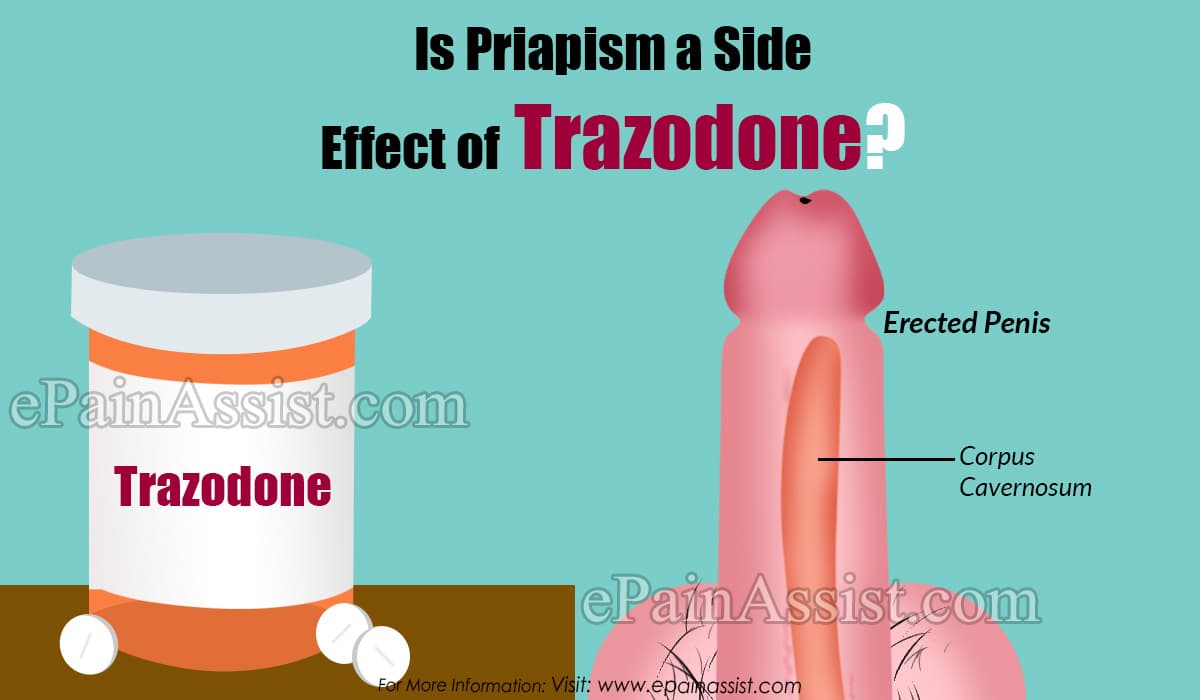
Is Priapism a Side Effect of Trazodone?
Trazodone has been linked to the occurrence of priapism as well as prolonged penile erection. A few factors can lead to trazodone-induced priapism including increased dosage. Patients who are accustomed to a steady dose of the drug can be at risk of priapism if their dosage is increased. For example, if you normally take 150 mg then increase your dose to 300 mg, you could develop priapism. However, the occurrence is rare and doesn’t apply to every male person who is prescribed to this antidepressant.
Trazodone does not interact well with hard drugs and alcohol, which can also increase the risk of prolonged erection. Other than medication, priapism can also be as a result of drug abuse of marijuana, alcohol, cocaine, and heroin. So, if you are under the influence and still taking trazodone, then you are at a greater risk of developing priapism, than someone who isn’t abusing drugs. Patients with clotting disorders should also refrain from trazodone as well. This can be based on the interaction of the drug and the state of their conditions, which could increase the risk of priapism. Trazodone is a triazolopyridine derivative that works as a postsynaptic 5-HT2a antagonist with alpha-adrenergic antagonist effects. In some patients, this antagonism effect at alpha-adrenergic receptors may trigger the onset of prolonged painful penile erections causing priapism.
What is Trazodone?
Trazodone falls under the category of antidepressant medication used in treating depression. Other than that, it helps with anxiety and sleep disorders. Patients are advised to be cautious with the medication and follow prescriptions as it has some adverse effects on one’s behavior. This especially applies when starting out on the dosage, whereby it increases the chances of being suicidal. In addition to that, trazodone has withdrawal effects if one stops taking the medication abruptly. The appropriate dosage for trazodone is 150 mg, but your doctor can increase the dosage as deemed necessary up to 300 mg. Before taking trazodone, you should be aware of which drugs it can interact with and those it cannot. This is because some drugs may affect how trazodone works or vice versa, thus, causing problems.
Common Side Effects of Trazodone
The common side effects of trazodone include:
- Headache
- Nausea, vomiting, and stomachaches
- Dizziness
- Erectile dysfunction (loss of interest in sex)
- Constipation or diarrhea
- Confusion
- Blurred vision
- Sweating
- Weakness and fatigue
- Dry mouth or dry eyes
Other side effects which are more severe include;
- Worsening depression
- Suicidal thoughts
- Chest pains and difficulty breathing
- Seizure
- Priapism (a painful erection that does not go away)
- Panic attacks
- Irregular heartbeat
- Fainting.
- Hallucinations
In the case of the mentioned side effects of trazodone which can be severe, you should stop taking the medication and inform your doctor immediately. The aim is to prevent further health complications which may be difficult to manage. If you overdose on trazodone, you are likely to experience vomiting, abnormal heartbeat, painful erection, drowsiness, and trouble breathing. During pregnancy, mothers should refrain from the drug as it may harm the developing fetus.
Conclusion
Drug-induced priapism accounts for about 20 to 40 percent of cases, especially with antidepressants and antihypertensives. Trazodone is an antidepressant that poses a small, yet definite risk of priapism. It is used in treating insomnia as well as depression and anxiety. The mechanism behind how the drug works could be a resulting factor on its own, whereas other factors such as abuse of drugs or clotting disorders, might have an additional risk. In cases where trazodone has caused priapism, the medication needs to be stopped immediately. This will reduce the risk of priapism reoccurring and you can salvage your manhood altogether.
Also Read:
